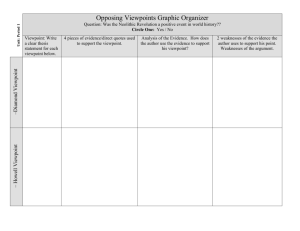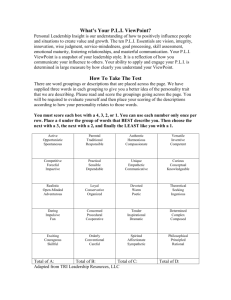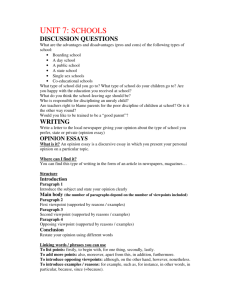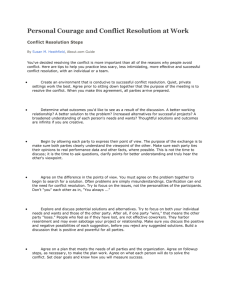Software Requirements and the Requirements Engineering Process
advertisement
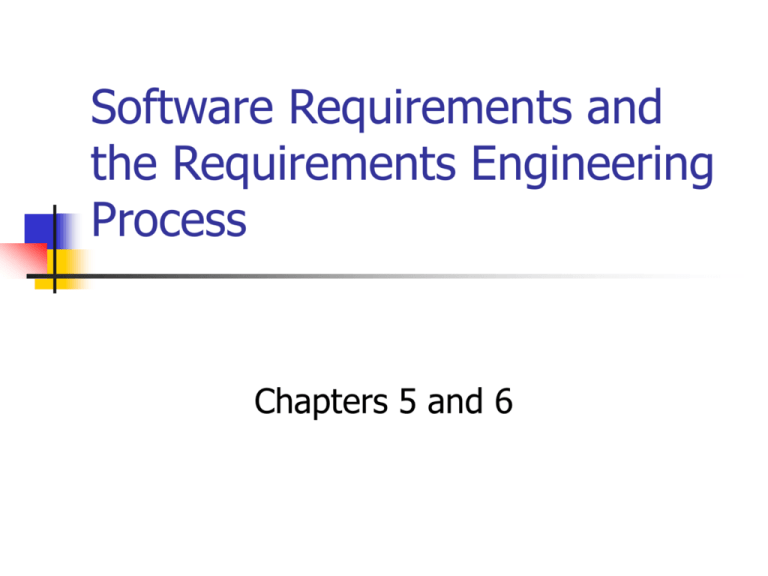
Software Requirements and the Requirements Engineering Process Chapters 5 and 6 References Software Engineering. Ian Sommerville. 6th edition. Pearson. Code Complete. Steve McConnell. (CC) The art of requirements triage. Alan M. Davis. Computer. IEEE. March 2003. Testing whether requirements are right. Robin F. Goldsmith, JD. Go Pro Management Inc. NYC Spin Meeting. December 2004. (RG) Software Requirements. Karl E. Wieger. Windows Press. Dr. Gotel’s research web page Dr. Barrett slides, NYU Requirements elicitation and analysis Stakeholder: Person or group of persons who will be affected by the system (directly or indirectly) All stakeholders should be involved in requirements elicitation and analysis Stakeholders don’t know what they really want Stakeholders express requirements in their own terms Different stakeholders may have conflicting requirements Organisational and political factors may influence the system requirements The requirements change during the analysis process. New stakeholders may emerge and the business environment change Different techniques for requirements elicitation and analysis Different techniques for elicitation: Brainstorming Stories Prototyping Questionnaires Interviewing Viewpoint Scenarios Use cases Requirements analysis Read the paper ‘The Art of Requirements Triage’, Alan Davis, IEEE computer, March 2003 Prioritization, estimation of the resources to satisfy the requirements, subset of requirements that optimizes the probability of the system’s success MoSCoW Criteria for requirements triage: M – Must have – mandatory requirements that are fundamental to the system S – Should have – important requirements that could be omitted C – Could have – optional requirements W – Want to have – the requirements really can wait Interviewing and questionnaires Interviewing: synchronous elicitation technique Questionnaires: asynchronous elicitation technique Based on: Ask questions and listening/reading the answers Be prepared to ask follow-up questions Ask for documents you need Log the answers (to support, complete or contradict what was said/written) Involve all the stakeholders Viewpoints Viewpoints permits us to classify stakeholders and other sources of requirements Multi-perspective analysis / diversity of source of information are important 3 categories of viewpoints Interactor viewpoints: People or other systems that interact with the system Indirect viewpoints: Stakeholders who do not use the system directly but who influence the requirements in some ways Domain viewpoints: Domain characteristics and constraints Viewpoints More specific viewpoints: Providers and receivers of system services Systems interfacing with the new system Regulations and standards applying to the system Sources of business and non-functional requirements Engineering viewpoints: developing, managing, maintaining the system Marketing viewpoints The VORD method This method implements a viewpoint-oriented approach for requirements elicitation VORD = Viewpoint Oriented Requirements Definition It is based on: Viewpoint identification Viewpoint structuring Allocating services to viewpoints Viewpoint data/control Group the viewpoints into a hierarchy Viewpoint documentation Discovering the viewpoints, services and constraints Refine the description of the viewpoints, services and constraints Use of a template Viewpoint system mapping Transform the analysis to an object-oriented design VORD template Vie wpoint te mplate Re feren ce : The viewpoint name. Attribu tes: Attributes providing viewp oint information. Eve nts: A reference to a set of event scenarios describing how the system reacts to viewp oint events. S e rvices A reference to a set of service descriptions. S ub-VPs: The names of subviewp oints. S e rvice template Re feren ce : The service name. Rationale: Reason why the service is provided. S pecification: Reference to a list of service specifications. These may be expressed in different notations. Vie wpoints: List of viewpoint names receiving the service. Non -function al Reference to a set of non requiremen ts: functional requirements which constrain the service. Provider: Reference to a list of system objects which provide the service. Example: ATM Viewpoint identification Query balance Machine supplies Get transactions Customer database Account holder Remote diagnostics Card returning Manager Message log Account information User interface System cost Stolen card Reliability Cash withdrawal Foreign customer Order statement Update account Software size Printe r Hardware maintenance Funds transfer Transaction log Remote software upgrade Order cheques Bank teller Invalid user Security Message passing Card retention Card validation Example: ATM Viewpoint structuring: Allocating services to viewpoints ACCOUNT HOLDER Service list Withdraw cash Query balance Or der cheques Send message Transaction list Or der statement Transfer funds FOREIGN CUSTOMER Service list Withdraw cash Query balance BANK TELLER Service list Run diagnostics Add cash Add paper Send message Example: ATM Viewpoint structuring: Viewpoint data/control ACCOUNT HOLDER Control input Start transaction Cancel transaction End transaction Select service Da ta input Card details PIN Am ount required Message Example: ATM Viewpoint structuring: Viewpoint hierarchy All VPs Services Query balance Withdraw cash Services Order cheques Send message Transaction list Order statement Transfer funds Customer Account holder Foreign customer Bank staff Teller Manager Engineer Example: ATM Viewpoint documentation Reference: Customer Reference: Cash withdrawal Attributes: Account number PIN Start transaction Events: Select service Cancel transaction End transaction Rationale: To improve customer service and reduce paperwork Services: Cash withdrawal Balance enquiry Specification: Users choose this service by pressing the cash withdrawal button. They then enter the amount required. This is confirmed and, if funds allow, the balance is delivered. VPs: Sub-VPs: Account holder Foreign customer Customer Deliver cash within 1 minute Non-funct. requirements: of amount being confirmed Provider: Filled in later Scenarios If it often easier for people to relate on real-life example rather than abstract statements Scenarios are descriptions – sequences of events of how the system is used in practice. Scenarios are composed of: A description of the initial state of the system A description of the normal flow of events in the scenario A description of what can go wrong and how it is handled Information on other activities that might be going on concurrency A description of the final state of the system Use cases Use cases are a scenario-based technique for describing requirements Use cases identify the users of the system (actors) Use cases identify the tasks (use cases) Use cases relate the users and the tasks Use cases are typically illustrated with UML as stick figures or similar diagrams A set of use cases should describe all possible interactions with the system Use cases are more effective in capturing functional requirements Example: Flights reservation system Use-cases relationships Use cases have relationships Inclusions: Extensions: A use case contain the behavior from another use case (unconditional) Can be seen as a factorization Introduced by the <<include>> keyword A use case conditionally interrupts the execution of another use case to augment its functionality An extension point may specify a precondition for the extending behavior Introduced by the <<extends>> keyword Inheritance Flights reservation system Requirements specification Examples of templates (Available in the Blackboard): Microsoft template. Karl E. Wiegers. Software Requirements. Windows Press. Volere template http://www.volere.co.uk Textual descriptions of a usecases The textual description of a use case includes: Use case ID Use case name Actors Description Pre-condition Post-condition Normal course Alternative course Exceptions Includes Priority See also template of Karl E. Wiegers, Microsoft Requirements validation Requirements must be checked for: Validity, comprehensibility, traceability (source, dependency between requirements) consistency, completeness, realism and verifiability Validation techniques: Requirements reviews Test-case generation Tests are developed for the requirements Prototyping Mini-definitions of the requirements Expert review, two independent reviews Formal/informal Involvement of the stakeholders necessary A team redefine the requirements and compare them with the list of produced requirements There are lots of validation techniques (more than 21). Dr. Goldsmith’s presentation. Requirements management Requirements management deals with the process of managing changes in the requirements during the requirements engineering process and system development Requirements traceability is concerned with the relationships between requirements (dependencies), their sources and the system design CASE tools are necessary for the requirements storage and management Traceability matrix U: Uses W: Weak relationshi p A traceability matrix permits us to see the relationships/dependencies between requirements Req. id 1.1 1.2 1.3 2.1 2.2 2.3 3.1 3.2 1.1 1.2 1.3 U R U R 2.1 2.2 2.3 3.1 R 3.2 U R R R U U U U R R

